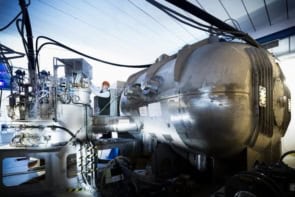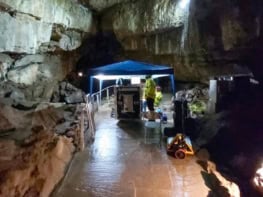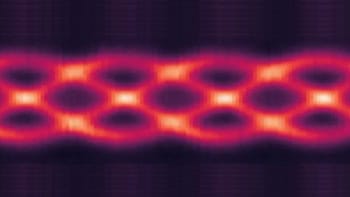
A curious effect called “Klein tunnelling” has been observed for the first time in an experiment involving sound waves in a phononic crystal. As well as confirming the century-old prediction that relativistic particles (those travelling at speeds approaching the speed of light) can pass through an energy barrier with 100% transmission, the research done in China and the US could lead to better sonar and ultrasound imaging.
Quantum tunnelling refers to the ability of a particle to pass through a potential-energy barrier, despite having insufficient energy to cross if the system is described by classical physics. Tunnelling is a result of wave–particle duality in quantum mechanics, whereby the wave function of a particle extends into and beyond a barrier.
Normally, the probability that tunnelling will occur is less than 100% and decreases exponentially as the height and width of the barrier increase. However, in 1929 the Swedish physicist Oskar Klein calculated that an electron travelling at near the speed of light will tunnel through a barrier with 100% certainty – regardless of the height and width of the barrier.
Relativistic quasiparticles
Testing this remarkable prediction has proven difficult because of the challenges of accelerating electrons to the required velocity and creating an appropriate barrier for tunnelling. More recently, physicists have discovered that the collective behaviour of electrons in graphene creates massless quasiparticles moving at near to the speed of light. While some indirect features of Klein tunnelling have been seen in graphene, conclusive evidence for 100% transmission has remained elusive.
In this latest work, Xiang Zhang at the University of Hong Kong and colleagues have built an experimental system that uses sound waves to simulate the behaviour of relativistic quasiparticles in graphene. To do this the team created a barrier using two different 2D triangular lattices made from acrylic cylinders (see figure). Just as the 2D atomic lattice of graphene affects the behaviour of electrons in graphene, these phononic crystals affect the behaviour of sound waves – creating quasiparticle acoustic excitations that behave like relativistic electrons.
While the two phononic crystals had the same lattice constant (the separation between cylinders is 28 mm in both), they are each made of cylinders with different radii (12 mm and 7 mm). The tunnelling barrier was created by sandwiching a region of 7 mm lattice between two regions of 12::mm lattice. While the acoustic quasiparticles can move easily in the 12 mm regions, they encounter a potential barrier within the 7 mm region.
Near-perfect transmission
Quasiparticles were created by injecting sound waves into one side of the phononic crystal. Instead of only some of the quasiparticles tunnelling through the barrier, the team measured near 100% transmission. They then tested several systems with different barrier thicknesses and different potential barrier heights – the latter can be adjusted by changing the radii of the cylinders in the barrier lattice. As predicted by Klein, the near-perfect transmission was unaffected by changing these two parameters.

Quantum-tunnelling time is measured using ultracold atoms
Klein tunnelling was observed for sound over a broad frequency range and the response of the system can be fine tuned by adjusting the size and spacing of the cylinders. As a result, Zhang and colleagues believe that their discovery could be used to boost the transmission of sound waves across interfaces. This could improve sonar systems used for exploring underwater regions and could also lead to the development of new medical ultrasound systems that are better able to see through obstacles within the body.
The research is described in Science.



